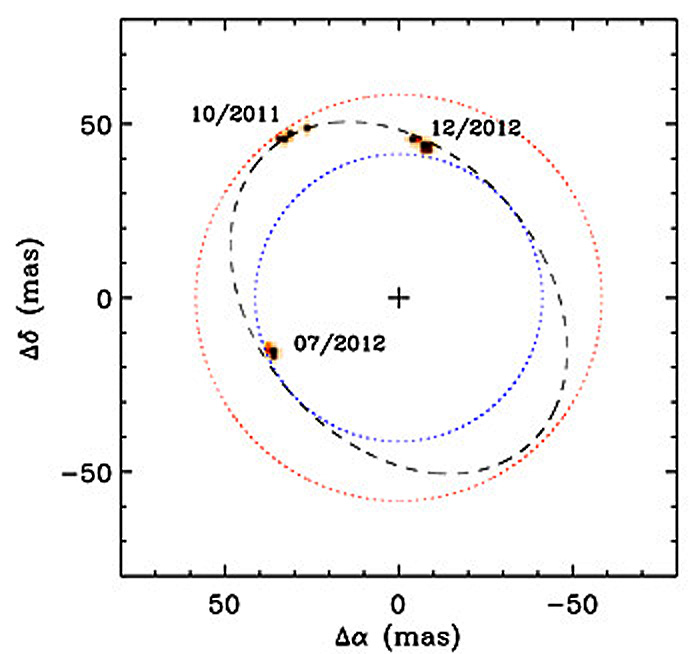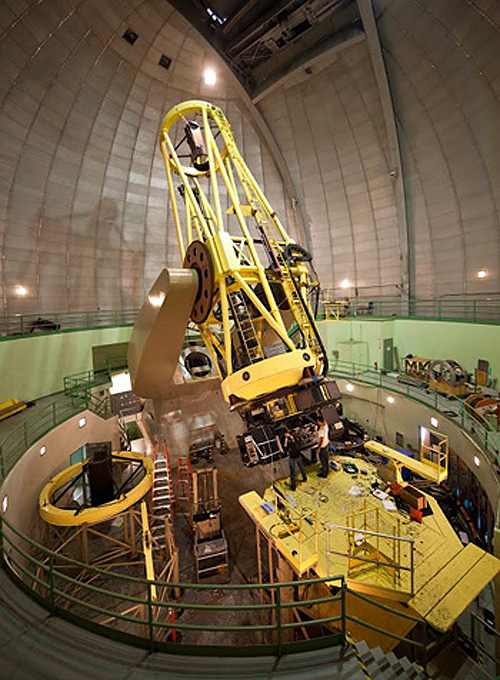.
Most stars in the galaxy are surrounded by swirling disks of dust, circling planets or other orbiting stars, yet astronomers have a hard time studying these companions because of glare from the main star.
.

Until now, the binary star system Capella appeared in visible light telescopes as a single ‘star’ larger than the red dotted circle. FIRST was able to resolve the two stars and, based on six individual observations at three different times over a 14 month time period, confirm the proposed elliptical orbit of one of these stars around its companion. Image by Gaspard Duchene/UC Berkeley and Franck Marchi/SETI Institute.
.
A new instrument that combines two high-resolution telescope techniques – adaptive optics and interferometry – has for the first time distinguished and studied the individual stars in a nearby binary star system, demonstrating promise for eventually picking out planets that have been indistinguishable from the stars they orbit.
In the December issue of the journal Astronomy & Astrophysics, University of California, Berkeley, astronomers and an international team of colleagues report that they were able to resolve in visible light the two stars in the binary star system Capella, which orbit one another at about the distance of Venus from the sun and until now have been indistinguishable from Earth. Capella is 43 light years from Earth and the brightest star in the constellation Auriga.
The team, led by UC Berkeley assistant research astronomer Gaspard Duchêne, used a prototype instrument called the Fibered Imager foR Single Telescope (FIRST) that was mounted three years ago on the Shane 3-meter telescope at the University of California Lick Observatories in San Jose.
“This really is a window on a unique combination of contrast and resolution that is not available today for viewing the close environment around stars,” Duchêne said.
Earlier this year, the astronomers mounted an improved instrument on the Subaru 8-meter telescope in Hawaii that has the potential to one day distinguish or resolve Earth-size exoplanets around M-type “dwarf” stars, which are slightly smaller and cooler than the sun. Imaging exoplanets is a hot field for astronomers, who learned last month that our galaxy may contain 40 billion or more potentially habitable planets circling M stars or stars like the sun.
“With the FIRST instrument at Subaru telescope, we expect to be able to resolve giant and super giant stars and observe the close environment of debris disks around young stars,” said coauthor Franck Marchis, a research astronomer at the SETI Institute in Mountain View, Calif. Marchis initiated the Lick project in 2009 while at UC Berkeley.
.
FIRST uses fiber optics
.
The FIRST instrument at Lick Observatory uses fiber optic communication cables to channel visible light from 18 different spots on the main mirror of the telescope to a detector, where the light beams interfere to reveal high-resolution detail in the same way radio telescope arrays use interferometry to achieve high-resolution radio images of the sky. The FIRST instrument on the Subaru telescope also uses 18 fiber optic cables to sample spots on a larger 8-meter main mirror. The 3-meter Lick and 8-meter Subaru telescopes are already equipped with adaptive optics, which creates sharper images by removing the jiggle in stars caused by turbulence in the atmosphere. The adaptive optics system provides a very stable image, which is key to allowing FIRST to inject the light from the star into the precise center of the fibers, which have a core a mere 4 micrometers in diameter.
.

Franck Marchis and colleague mount the FIRST instrument on the Shane 3-meter telescope at Lick Observatory.
.
The key advantage of FIRST is that it can resolve very close objects, such as close binary stars or the disks of dust and gas that circle stars in the process of forming planets. It can even resolve the surface features on red super giant stars, which bloat to the diameter of Earth’s orbit. Other techniques are limited by the turbulent glare from the stars, which is effectively removed by the use of fibers in FIRST.
At the moment, however, FIRST cannot resolve objects that differ in brightness by more than 50-100 times. Planets the size of Jupiter are typically 10,000-100,000 times fainter than their stars, while Earth-size planets are a million times fainter.
“If we could add enough fibers, we could get very high contrast; that is the goal,” Duchêne said. “If we can scale this up to look for planets, it would be very, very exciting.”
FIRST also can simultaneously obtain a spectrum of each object, providing critical information on the chemical composition and temperature of the stars, debris disks or planets, he said.
One of the key components of the system is a tiny movable mirror, a microelectromechanical systems or MEMS device, that directs starlight into the optical fibers, which channel the light without much loss to the image. The MEMS device was developed by a UC Berkeley spinoff called IRIS AO, Inc., based only a few blocks from UC Berkeley’s astronomy department.
Coauthors with Duchêne and Marchis are E. Huby, S. Lacour, G. Perrin and É. Choquet of the Observatoire de Paris; T. Kotani of the National Astronomical Observatory of Japan; E. L. Gates of Lick Observatory; O. Lai of the Gemini Observatory in Hawaii; and F. Allard of the Université de Lyon.
The FIRST project on the Lick 3-meter Shane telescope was funded by Programme National de Physique Stellaire (PNPS) in France, a Small Research Grant of the American Astronomical Society, NASA (grant NNX11AD62G) and the National Science Foundation (award # AAG-0807468).
Quelle: UC Berkeley
5653 Views
